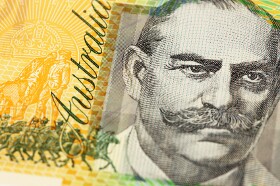
The Australian dollar fell today, declining for the fifth consecutive trading session versus such majors as the US dollar and the Japanese yen. While the Aussie also fell against the euro initially, the shared currency of the eurozone has lost its gains by now. The reasons for the decline of Australia’s currency were the prospects for additional interest rate cuts from the Reserve Bank of Australia and unfavorable Australian macroeconomic data released during the Tuesday’s session.
The RBA released minutes of its monetary policy meeting from two weeks ago, at which policy makers decided to cut the main interest rate by 25 basis points. The notes explained the decision:
Taking into account all the available information, the Board decided that it was appropriate to lower the cash rate by 25 basis points at this meeting. A lower level of the cash rate would assist in reducing spare capacity in the labour market, providing more Australians with jobs and greater confidence that inflation will return to be comfortably within the medium-term target range in the period ahead.
What is important, the minutes signaled that additional cuts are more likely than not:
Given the amount of spare capacity in the labour market and the economy more broadly, members agreed that it was more likely than not that a further easing in monetary policy would be appropriate in the period ahead.
The labor market will be the most important factor for deciding whether to cut rates again or not:
Members agreed that, in assessing whether further monetary easing was appropriate, developments in the labour market would be particularly important.
Surprisingly, the central bank suggested that interest rates are not the only tool in its toolbox that it can use for supporting the jobs market:
They also recognised, however, that lower interest rates were not the only policy option available to assist in lowering the rate of unemployment, consistent with the medium-term inflation target.
Meanwhile, the Australian Bureau of Statistics reported that the house price index fell 3.0% in the March quarter from the previous three months. Analysts had predicted the drop to be about the same as in the December quarter — 2.4%.
AUD/USD declined from 0.6852 to 0.6845 as of 10:55 GMT today, while its daily low was at 0.6831. AUD/JPY went down from 74.36 to 74.13, touching the low of 73.92 intraday. At the same time, EUR/AUD was almost flat at 1.6367 after rallying to the high of 1.6447 earlier.
If you have any questions, comments, or opinions regarding the Australian Dollar, feel free to post them using the commentary form below.